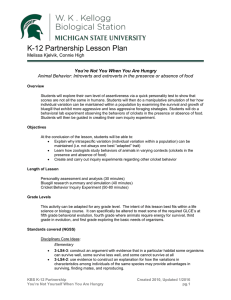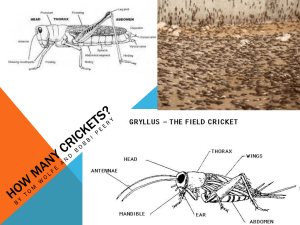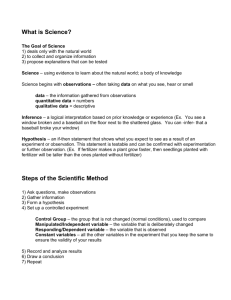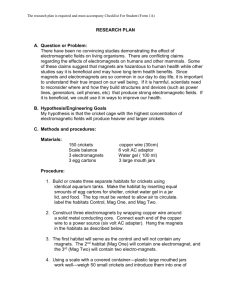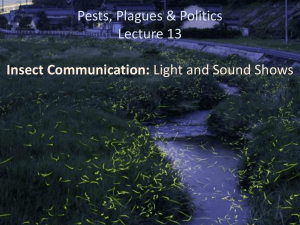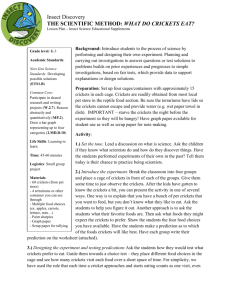Lesson plan - KBS GK12 Project
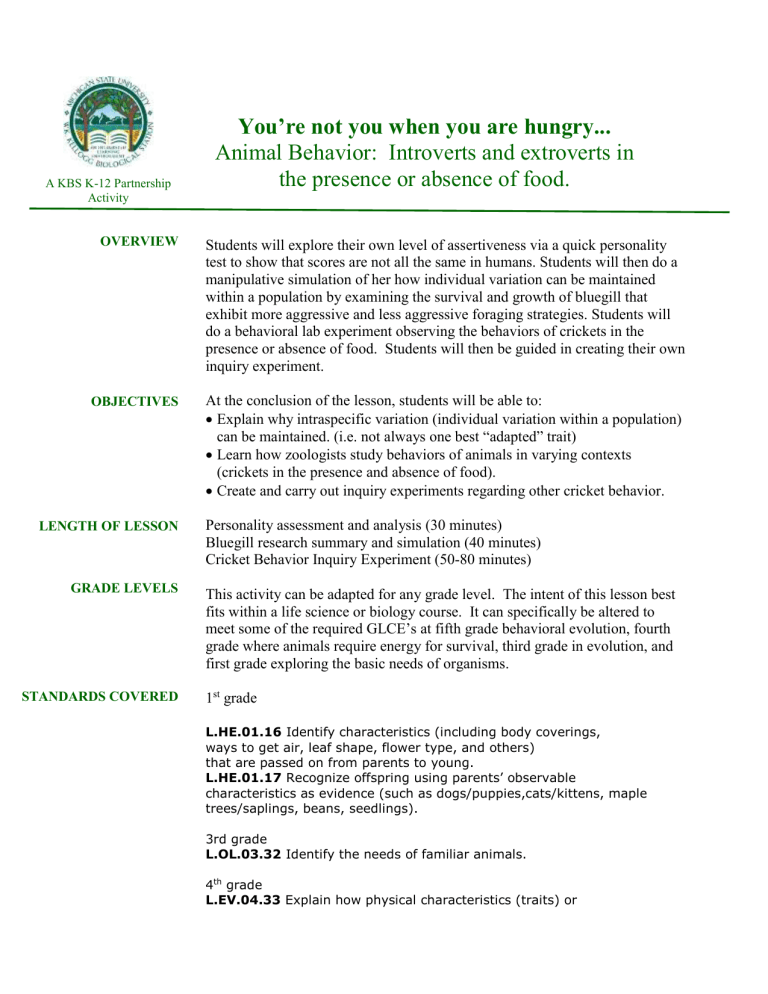
You’re not you when you are hungry...
Animal Behavior: Introverts and extroverts in the presence or absence of food.
A KBS K-12 Partnership
Activity
OVERVIEW
OBJECTIVES
LENGTH OF LESSON
GRADE LEVELS
STANDARDS COVERED
Students will explore their own level of assertiveness via a quick personality test to show that scores are not all the same in humans. Students will then do a manipulative simulation of her how individual variation can be maintained within a population by examining the survival and growth of bluegill that exhibit more aggressive and less aggressive foraging strategies. Students will do a behavioral lab experiment observing the behaviors of crickets in the presence or absence of food. Students will then be guided in creating their own inquiry experiment.
At the conclusion of the lesson, students will be able to:
Explain why intraspecific variation (individual variation within a population) can be maintained. (i.e. not always one best “adapted” trait)
Learn how zoologists study behaviors of animals in varying contexts
(crickets in the presence and absence of food).
Create and carry out inquiry experiments regarding other cricket behavior.
Personality assessment and analysis (30 minutes)
Bluegill research summary and simulation (40 minutes)
Cricket Behavior Inquiry Experiment (50-80 minutes)
This activity can be adapted for any grade level. The intent of this lesson best fits within a life science or biology course. It can specifically be altered to meet some of the required GLCE’s at fifth grade behavioral evolution, fourth grade where animals require energy for survival, third grade in evolution, and first grade exploring the basic needs of organisms.
1 st
grade
L.HE.01.16 Identify characteristics (including body coverings, ways to get air, leaf shape, flower type, and others) that are passed on from parents to young.
L.HE.01.17 Recognize offspring using parents’ observable characteristics as evidence (such as dogs/puppies,cats/kittens, maple trees/saplings, beans, seedlings).
3rd grade
L.OL.03.32 Identify the needs of familiar animals.
4 th grade
L.EV.04.33 Explain how physical characteristics (traits) or
MATERIALS
BACKGROUND adaptations of animals (sharp teeth or claws for catching and killing prey, or color for camouflage) help them to survive in their environments.
5 th grade
L.EV.05.25 Describe the attributes of organisms that help them survive.
L.EV.05.27 Explain how behavioral characteristics (adaptation, instinct, learning, habit) of animals help them to survive in their environment.
High School
B1.1E Describe a reason for a given conclusion using evidence from an investigation.
B1.1g Use empirical evidence to explain and critique the reasoning used to draw a scientific conclusion or explanation.
B1.1i Distinguish between scientific explanations that are regarded as current scientific consensus and the emerging questions that active researchers investigate.
B5.1A Summarize the major concepts of natural selection (differential survival and reproduction of chance inherited variants, depending on environmental conditions.)
B5.1e Explain how natural selection leads to organisms that are well suited for the environment (differential survival and reproduction of chance inherited variants, depending on environmental conditions).
Personality Test
Graph Paper
Aquariums or plastic habitats
Sticks and leaves from outdoors
Timers
Dog food
Four colors of fingernail polish
Crickets (can be purchased at a pet store.)
20 small fish manipulatives per group
20 large fish manipulatives per group
Stickers for marking fish
Intraspecific (intra=within, species) variation - individual variation of a trait
(length, weight, behaviors, immune response, etc.) within a species
Although the issue of maintaining biodiversity is not new, the focus of conservation efforts is typically at the species level. Species richness is a common variable to examine when investigating diversity of communities or ecosystems. A less familiar concept for teachers to teach is intraspecific variation- or how diverse a phenotypic trait can be within a species. Phenotypic variation is a necessity for evolution to occur by natural selection favoring certain phenotypes in various contexts.
But, what if intraspecific variation is maintained over evolutionary time? Why is there such variability in traits instead of every individual having an“optimal” phenotypic trait? Scientists have many hypotheses and the mechanism can vary
ACTIVITIES OF THE
SESSION in different systems. One such mechanism could be ecological tradeoffs. For example: there is variation in foraging behavior in bluegill sunfish such that some individuals are risk-takers and others are shy foragers. Why don’t all bluegill display one optimal behavior? It may be that bolder individuals consume more food and thus grow larger, faster (maturing faster and escaping predation by not fitting in a predator’s mouth) , but as a group experience higher mortality rates because of their risky habitat use. Shy individuals on the other hand may not grow as fast, but have higher survival probability. So which strategy is best? This type of tradeoff allows variation to be maintained by
“balancing” costs and benefits of divergent phenotypes.
Cricket behavior inquiry is a great way to address intraspecific variation because you will see differences in how crickets react to a variety of contexts
(novel territory, social interactions, mating calls, foraging risk, habitat use, etc) and students can answer questions they are most interested in.
It is not only important to acknowledge intraspecific variation as biodiversity, but also to realize that phenotypic variation is what natural selection acts on. If there was no variation, differential survival and reproduction would not occur, stagnating potential evolutionary adaptations.
Intraspecific variation in humans (e.g. students)
Have students individually take personality tests (form attached)
Gather the scores from each individual and graph the scores to show a distribution of personalities within the class. Ask students why there are a variety of personalities (i.e. some students shy, some assertive, aggressive, affectionate, etc) and not just one personality. Why are people the way they are? Genes? Environment? Biologically, why don’t we all act the same in similar contexts?
Simulation showing maintenance of intraspecific variation
Have students in small groups-each controlling one “bluegill population”
See attached document for rules and steps for the bluegill simulation game
Compare results from all the groups- how many bold and shy did each group choose to start with and how many bold and shy did each group end up with after the simulation?
Individual variation in cricket behavior
Tanks can be set up either ahead of time by teacher or with student help. Mulch and sticks can be placed in 10 gallon tanks for refuge habitats. Pet food can be used as a food supply and melons/fruit can be used for a water source (crickets tend to drown if there is openwater). If you are doing extended projects with the crickets you may prefer to cover the bottom of the tanks with sand/substrate for females to oviposit. If crickets are going to be used for a limited time, like in this activity, you may wish to use a dry-erase marker to put spatial grids on the bottom of the tanks to easily quantify cricket movement and behavior.
Once the tanks are setup and crickets acquired, mark each cricket with a dot of colored nail polish (one individual with each color per tank)
on their pronotum (segment in between head and wing attachment site).
Follow protocol on attached document to quantify differences in behaviors with and without food.
RESOURCES
MODIFICATIONS
Bluegill simulation rules and steps (.doc)
Cricket Inquiry protocol (.doc)
Website on cricket anatomy, behavior and calling http://entnemdept.ufl.edu/walker/buzz/487a.htm
Additional resources: an article in The American Biology Teacher (NABS) called “Cricket behavior: observing insects to learn about science and scientific inquiry.” This article has many ideas you can help your students discover with
“guided inquiry” by telling them interesting behaviors crickets exhibit and are commonly studied.
The types of behaviors observed and the level of data analysis/comparison
across groups can be modified for various grade levels.
Melissa Kjelvik http://kbsgk12project.kbs.msu.edu
